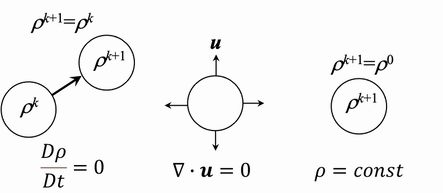In the MPS (Moving Particle Semi-implicit) method, one of the particle methods, incompressible fluids are solved as “constant density”. On the other hand, “velocity divergence zero” is used in the grid methods such as the Finite Volume Method. This difference is a typical characteristic of the MPS method, which is explained in this article.
When Koshizuka started to study particle methods in 1993, SPH (Smoothed Particle Hydrodynamics) had already been proposed as a particle method. SPH solves compressible fluids using an explicit algorithm, though most of the engineering problems are those of incompressible fluids which have been solved by the grid methods using a semi-implicit algorithm. Koshizuka sought a particle method that can solve incompressible fluids using a semi-implicit algorithm and finally reached the MPS method. But there is a difference from the existing grid methods and it is the essential idea of the MPS method.
Fundamental three physical laws of conservation are for mass, momentum, and energy. The conservation law of energy can be derived from the other two conservation laws of mass and momentum, so that the solution is obtained by solving two conservation laws. In fluid dynamics, the conservation law of mass called “continuity equation” and the conservation law of momentum called “Navier-Stokes equations” are solved simultaneously. This way is taken in the particle methods as well. Incompressibility is related to the conservation law of mass, “continuity equation”.
The continuity equation of compressible fluids is
$$ \frac{D \rho}{D t}+\rho \nabla \cdot \boldsymbol{u}=0 \qquad. $$In incompressible fluids, the first term of the left-hand side of Equation (1) is zero, and thus the second term is also zero:
$$ \frac{D \rho}{D t}=0 \qquad, $$ $$ \nabla \cdot \boldsymbol{u}=0 \qquad. $$In addition, by integrating Equation (2), the following equation representing the density being constant in time is obtained:
$$ \rho=\it{const} \qquad. $$(“\(\it{const}\)” in the right-hand side of Equation (3) means constant.)
Equation (4) means “density being constant”, which requires that the density should be calculated in each time step and be constant. This is the constraint condition used in the MPS method (Koshizuka and Oka, 1996). On the other hand, Equation (3), “velocity divergence being zero”, is used in the grid method. This condition can be employed in particle methods in place of Equation (4). Which is more essential as the incompressibility? Are they equivalent to each other (Figure 1)?

Figure 1 What incompressibility condition is essential ?
First, please consider the difference between Equations (4) and (3). The basic law is the continuity equation. This requires that the mass should be constant which means that Equation (4) is more essential. By differentiating Equation (4), we obtain Equation (2) representing density change in time is zero, and then Equation (3), velocity divergence being constant, is deduced by using Equation (1).
As an analogy of money savings, the deposit can be checked by confirming the amount of money, which is the way using Equation (4). Checking the balance between income and payment is like using Equation (3). If the calculation is accurate, two ways are equivalent. However, if there are possibilities of errors, checking the amount of money is direct and essential.

Figure 2 Ball motion on a curved surface
The next analogy is a rolling ball on a curved surface as shown in Figure 2(a). The direct constraint condition is that the ball should be on the curved surface, which corresponds to Equation (4) in the fluid dynamics. Differentiating the constraint condition in time, we obtain the condition that the ball velocity \(\boldsymbol{v}\) should be parallel to the curved surface (Figure 2(b)). This corresponds to Equation (3). When the motion of the ball during a small period \(\Delta t\) is considered, the movement is \(\boldsymbol{v} \times \Delta t\) and the ball may be a little inside the wall as shown in Figure 2(c). We can say “the constraint condition = differentiation of the time differentiation of the constraint condition” instantaneously but “the constraint condition ≠ differentiation of the time differentiation of the constraint condition” in the discretized calculation because of errors. From this consideration, we can say that Figure 2(a) is more essential than Figure 2(b). In the particle method, imposing Equation (3) as the incompressibility condition makes the fluid density gradually change due to the errors. The change is accumulated when time proceeds. Therefore, Equation (4) is essential, and Equation (3) is derivative as the incompressibility condition.
In SPH, there is a variation method employing “density being constant” as the incompressibility condition (Shao and Lo, 2003). This variation method has imported the concept of the MPS method and is called ISPH (Incompressible SPH). This is written in the paper of Shao and Lo (2003).
Next, which is superior, “density being constant” or “velocity divergence being constant”? The author thinks that “density being constant” is superior to “velocity divergence being constant” from the viewpoint of the robustness of the particle methods. In detail, there are advantages and disadvantages. Advantages of “density being constant” are that (1) the density error is not accumulated, (2) the particle distribution is kept uniform, and (3) the free-surface boundary condition is simple. A disadvantage is that the pressure distribution is likely to be oscillatory. The advantage and disadvantages of “velocity divergence being constant” are opposite. Then, an idea to mix Equations (2), (3), and (4) has been proposed (Kondo and Koshizuka, 2008; Tanaka and Masunaga, 2010). In keeping the advantages of “density being constant”, the disadvantage of the pressure oscillation is improved.
References
S. Koshizuka and Y. Oka, “Moving-Particle Semi-implicit Method for Fragmentation of Incompressible Fluid,” Nucl. Sci. Eng. 123, 421-434 (1996).
S. Shao and E. Y. M. Lo, “Incompressible SPH Method for Simulating Newtonian and non-Newtonian Flows with a Free Surface,” Adv. Water Resources 26, 787-800 (2003).
M. Kondo and S. Koshizuka, “Suppressing the Numerical Oscillation in Moving Particle Semi-implicit Method,” Trans. JSCES, Paper No.20080015 (2008). (in Japanese)
M. Tanaka and T. Masunaga, “Stabilization and Smoothing of Pressure in MPS Method by Quasi-Compressibility,” J. Comput. Phys. 229, 4279-4290 (2010).
TOC
Incompressibility of the particle method
- Incompressibility of the particle method
About The Author

Prof. Seiichi Koshizuka
Professor, Department of Systems Innovation, Graduate School of Engineering, The University of Tokyo
Founder and Outside Director, Prometech Software
Inventor of the particle method (MPS method)
View Profile
2004
Professor, Department of Quantum Engineering and Systems Science, Graduate School of Engineering, The University of Tokyo
2005
External Board Member, Prometech Software, Inc.
2008
Professor, Department of Systems Innovation, Graduate School of Engineering, The University of Tokyo
